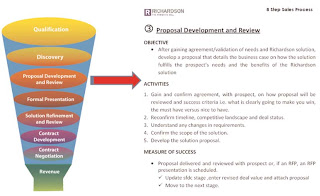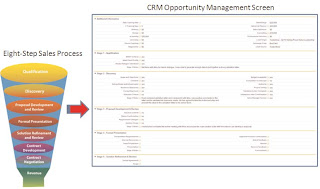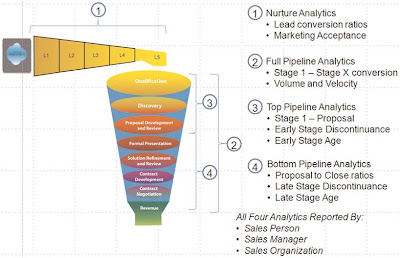A couple of weeks ago, I started a discussion on the fact that many companies are not seeing or receiving the true value of a CRM system. The question that I started to answer was: Is it your CRM or your sales people. Before reading the rest of this blog, make sure you get up to speed by reading the first one.
Let's now continue this discussion.
CRM systems don’t come with a best practice sales process and methodology. A sales process is the steps that your Salespeople take from prospecting to closing an opportunity, to then managing and expanding that account. A methodology is the combined “what” the Salespeople will do in each step of your process to achieve the desired results.

A good way to understand this is to look at an example. If you have an Eight-Step Sales Process, it should be embedded in your CRM system where your Salespeople are held accountable for following the process and entering the necessary data that is required to manage opportunities. This provides your team with the consistency in both behavior and data gathering that you need to improve your sales performance, forecasting, and success. As you can see in the example below, the process is embedded in the opportunity management screen where the Salespeople are held accountable for completing specific fields or “gates” of information before an opportunity can advance from one stage of the process to the next.

This creates a consistent opportunity management process and the required data for improved deal, pipeline, and revenue forecasting. But just building process and functionality into the screens is not enough. Your team members need training on how to follow the process, use the new screens, and understand the data requirements to grasp how all of this will benefit them directly.
Technology
Your CRM system more than likely does a good job of managing customers and opportunities – keeping current contact data, scheduling of events, and tracking specifics of opportunities. But does it also offer integrated sales tools that help Salespeople to accelerate opportunities, plan for client meetings, collaborate with their team members, and be coached by their Managers – all supporting your sales process and methodology? These additional technology tools allow them to hit their personal goals of getting to quota, going to club, and flat out making good money - thus giving your team members the value they need to see to want to use your CRM system.
Here are some best-practice examples of technology tools that can be integrated into your existing CRM system:
A Sales Call Planner. This particular tool is used for Salespeople to prepare for and execute successful sales meetings. It is supported by a best-practice sales methodology, embedded learning assets, and is delivered on a platform that allows Sales Managers to provide pre- and post-meeting coaching.
An Opportunity Accelerator. This technology tool is used in conjunction with the Sales Call Planner to ensure that Salespeople are following a best-practice sales process, have a tool to manage the strategy of an opportunity, and are able to collaborate with a deal team or their Manager on the execution of the opportunity.
People and Data
By having your sales process and methodology embedded in your CRM and providing technology tools to enhance value, your Salespeople will begin to change their behavior in how they use the CRM system. Additional training needs to be supplied to your people that will allow them to understand their business. When the proper process and tools are in place, and training and coaching have been delivered, your CRM system will start generating data that, when properly reported, will give you and your team insight into how everyone should be managing their business – or better said, their pipeline.
Providing reports centered on the sales process and how opportunities are flowing through the process are an important part of adding the final “value” to your Salespeople. This will allow them to see how their behaviors are affecting their business. This requires the reporting of key analytics that are then provided to your Salespeople and your Sales Managers that will allow them to see patterns in sales behaviors that need to be changed through additional training and coaching.
Let’s take a look at what a baseline list of these pipeline management analytics should be.
If your Salespeople do not have access to their key CRM metrics, they will not know how their behaviors are impacting their business. They will also not know how to properly forecast and develop the necessary action steps needed to improve their personal pipeline.

If we go back to our Eight-Stage Pipeline graphic (shown below), we can look at the main ways that Salespeople should manage their business. First, they should manage the prospecting and nurturing of leads – as shown in the L1-L5 section #1 of the pipeline graphic. This depicts a five-stage lead nurture process that is either driven by Marketing, Inside Sales, or the Field Sales Team. These are the leads that come into your company that are not yet qualified to be added to your pipeline. There are two key analytics that your Salespeople need to learn about these leads: their lead conversion ratios (how many leads make it to the pipeline) and their acceptance performance against leads that are provided to them by their Sales Team.
In section #2 of the pipeline graphic, the Sales Team needs to know their full pipeline conversion information (how many opportunities enter the pipeline in the first stage and conclude in sales). They also need to see the volume of what they are entering and the velocity (how fast) they move through the pipeline. This data needs to be compiled for each stage of the sales process.
The next set of analytics exist in sections #3 and #4 of the pipeline graphic. It is important to have analytics for the top and the bottom of your pipeline. Not all Salespeople are good at prospecting (hunters) and closing or managing accounts (farmers). It is important to understand individual performance levels in each section. With this data in hand and with each Salesperson trained on how to read and understand their personal analytics, Managers will be able to collaborate with their team members to coach against the sales process and pipeline behavior. This will drive consistency, better forecasting, and improved opportunity execution for your overall Sales Team and individual Salespeople.
By combining an embedded best-practice sales process and methodology, tools to support the process, and the reporting and management of pipeline performance, you will have developed a revenue management system that will help you to achieve your corporate and personal goals.
How Can Richardson Help?The Richardson Sales Readiness Service focuses on helping you develop and implement best practice sales processes and methodologies that drive the consistency and efficiency of your Sales Team. We will also work with you to build the necessary KPIs and embed it all in your CRM system so it can be reported, tracked, and managed. Our Pipeline Management courses build the business knowledge your Sales Team members need in order to improve how they manage their business and deliver your Managers the skills they need to coach to pipeline improvement.
To sustain behavior change, Richardson offers CRM-integrated tools that become part or your team’s everyday workflow and drive the consistency you need to succeed.
Visit Richardson’s website at
www.richardson.com for more information on how Richardson’s Sales Readiness Service can help your Sales Organization reach their objectives.




